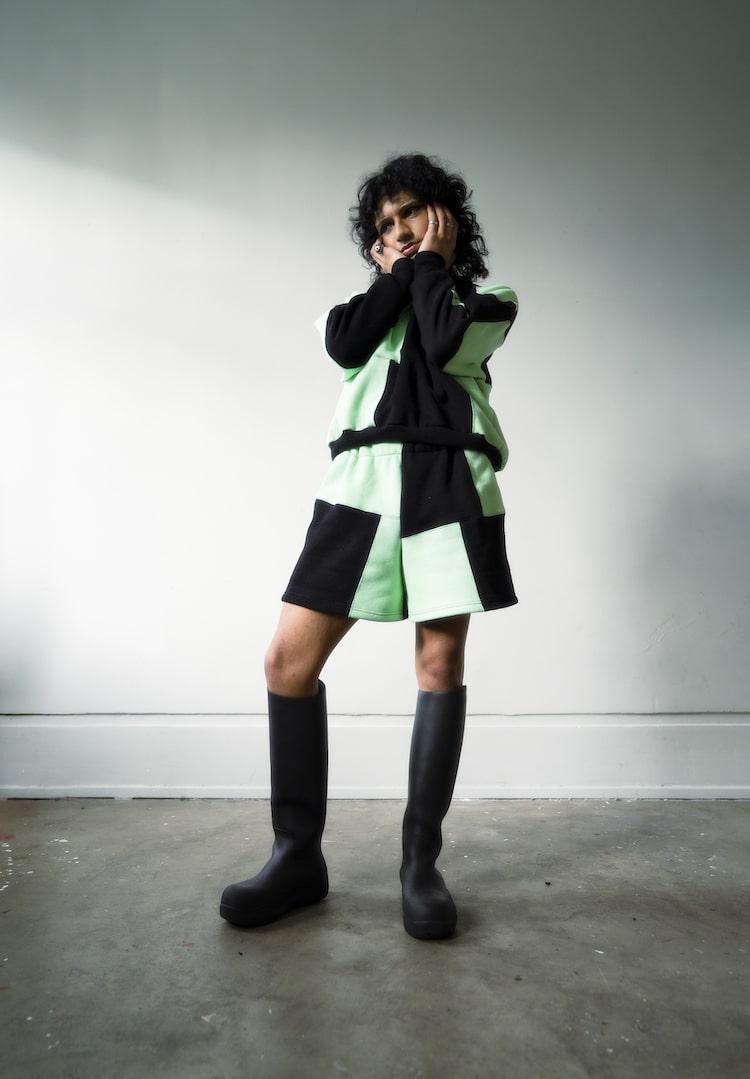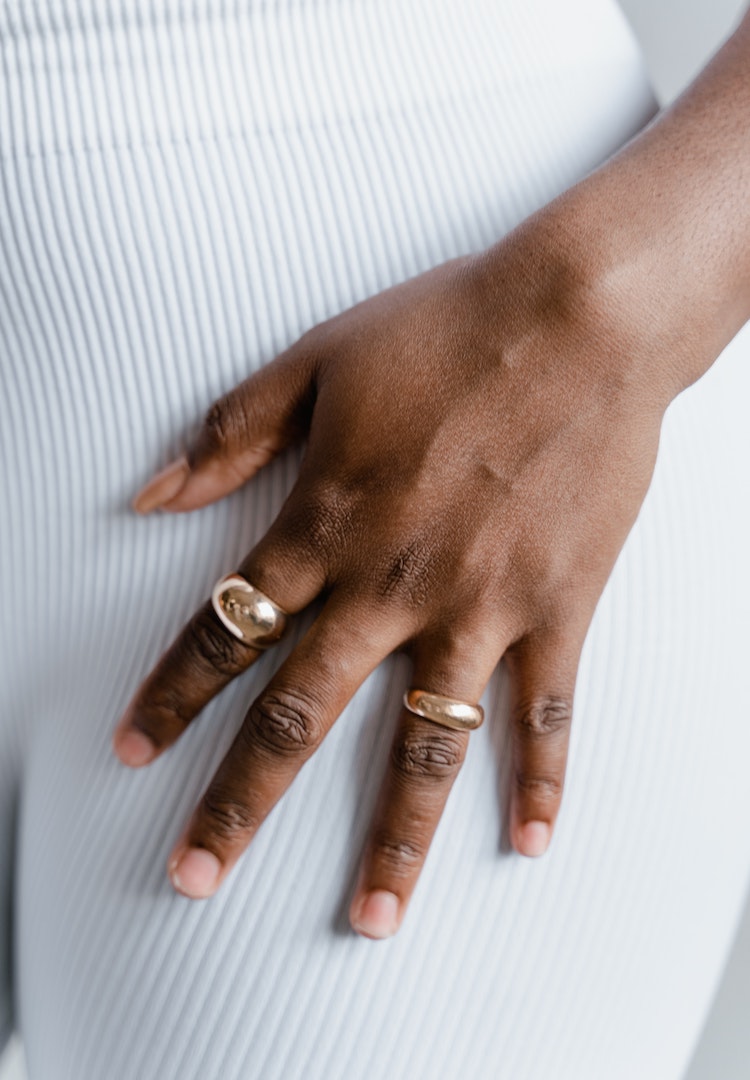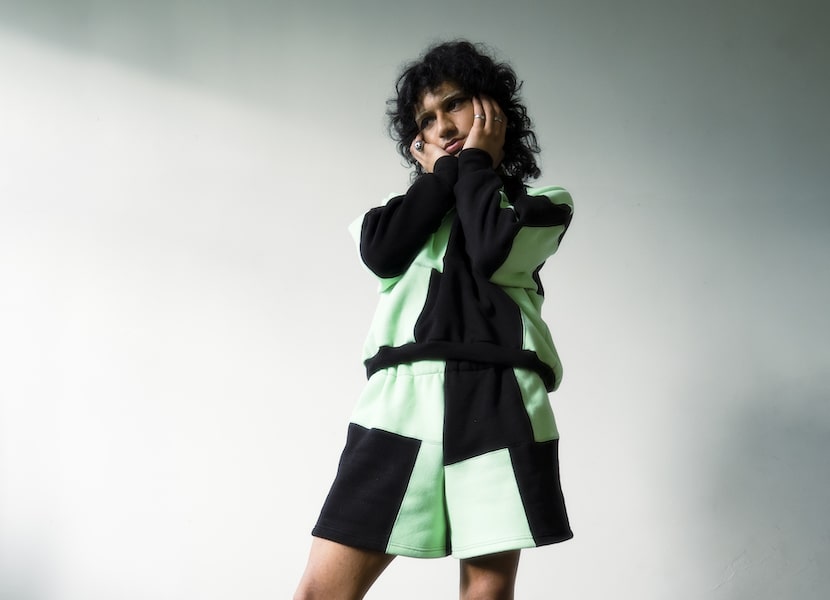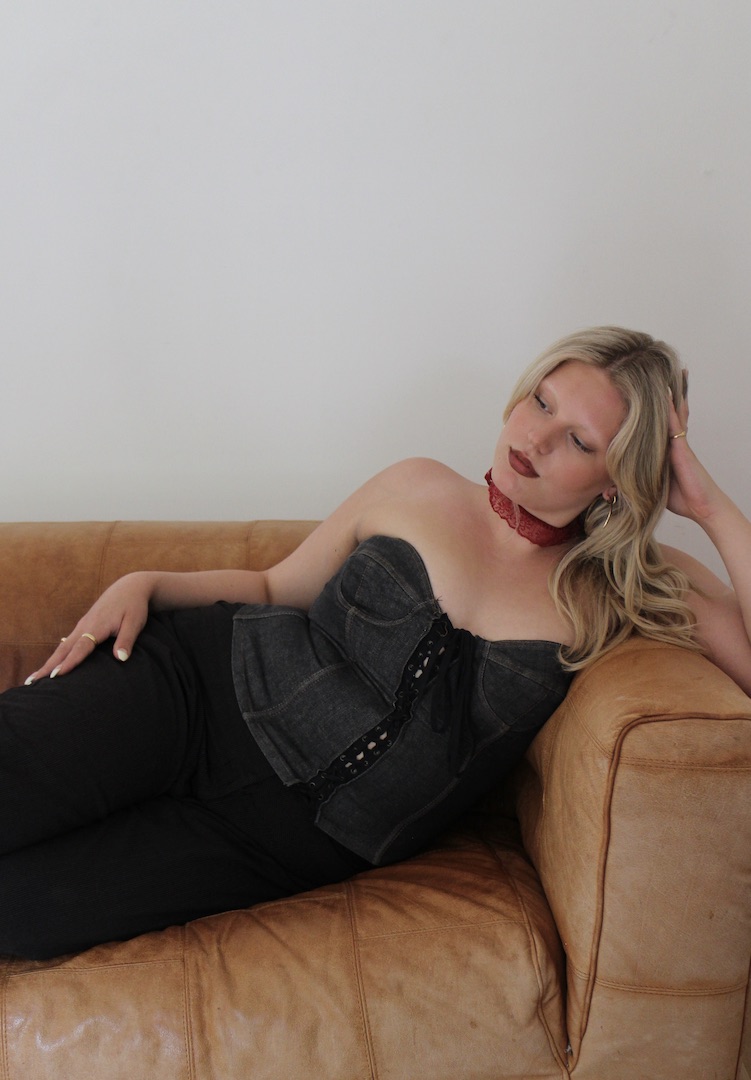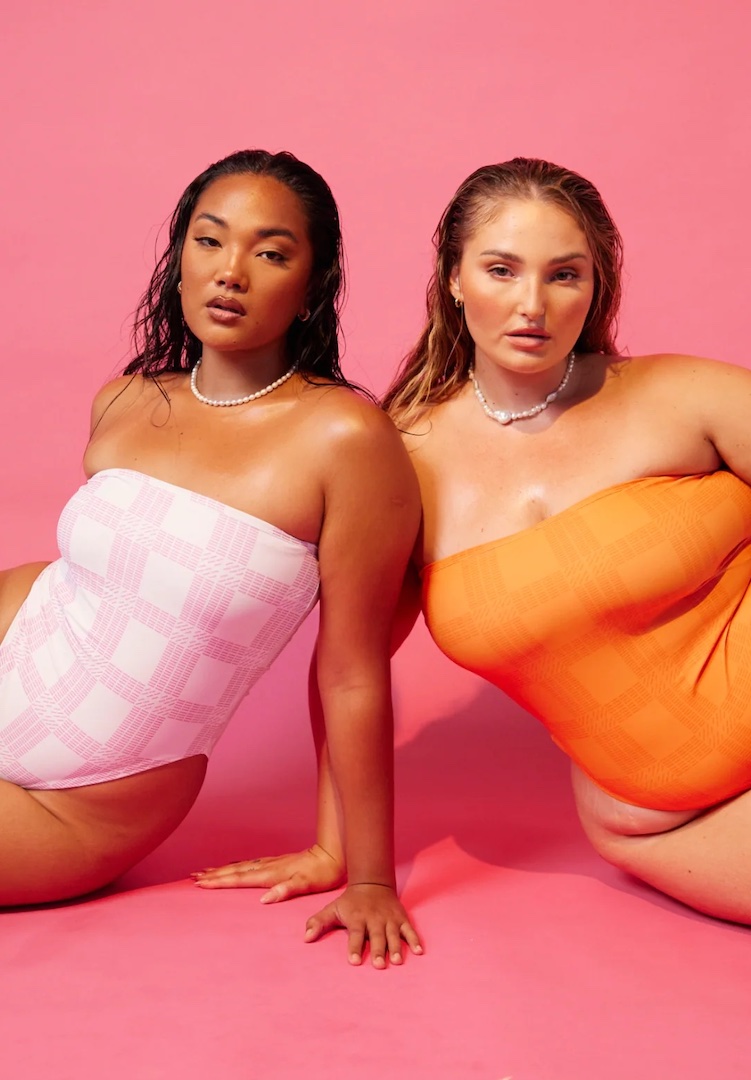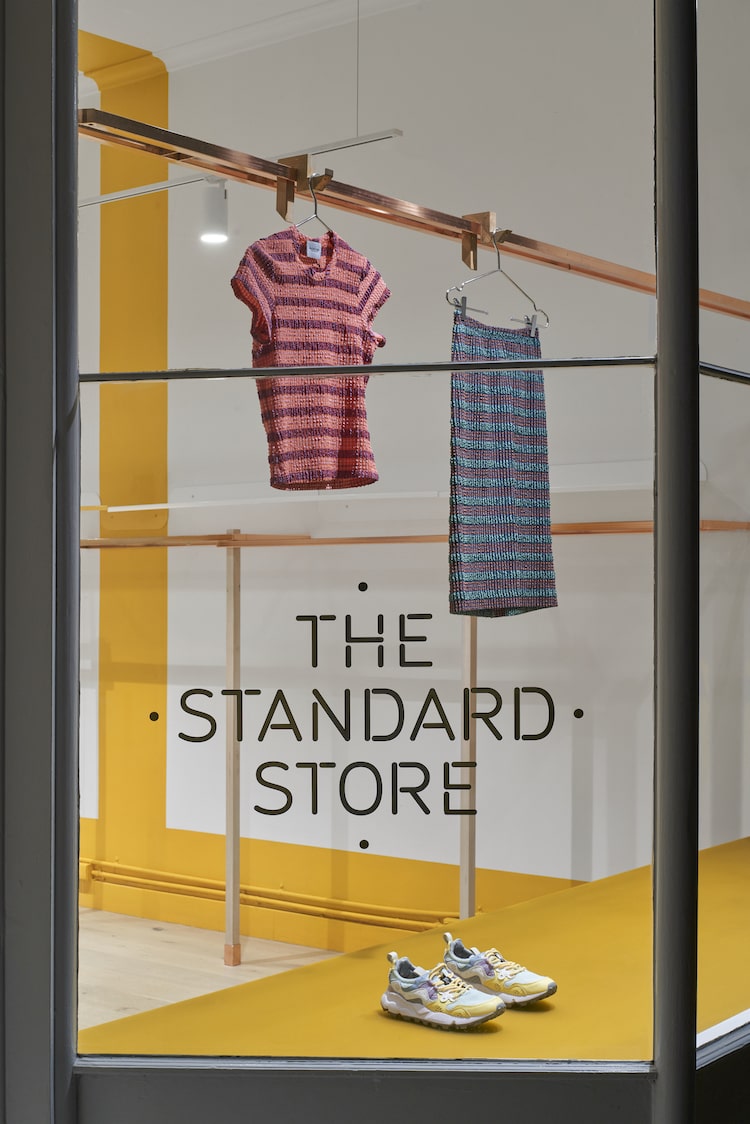New Zealand designer Nicole Van Vurren creates experimental pieces from scrap fabric
PHOTOGRAPHY BY YELLOW LINES MEDIA
WORDS BY IZZY WIGHT
“Ripped and torn edges, odd shapes, stains and footprints from being left on a dirty floor.”
In recent years, sustainable fashion has looked to the future. It’s no longer just about buying natural fibres, reducing your consumption and shopping secondhand – it’s about supporting the designers who are innovating their practices. The designers who are championing modular clothing, creating eco-friendly bioplastics and, in the case of New Zealand designer Nicole Van Vuuren, turning textile scraps into something truly beautiful.
While studying fashion in Dunedin, she would buy cheap pieces of offcut fabrics to use in her work. What started as a financial necessity soon became her brand as she fell in love with the “aesthetics of the scraps”. After graduating, Nicole took a design job at Eckhaus Latta and in her free time, began making garments with leftover fabrics and hand-sewing needles.
Looking for more fashion news and features? Head to our Fashion section.
Instead of moulding the textile to the garment, Nicole flipped her production process on its head. Working with the natural imperfections in these scrap fabrics, she built each piece to highlight these features. Three years on, Nicole’s eponymous collection is loved for its aesthetic, one which favours “the imperfect, unfinished, broken or unloved”. Below, she shares the story of the label so far.
Tell us about you. What’s your fashion background?
View this post on Instagram
I grew up in Christchurch, New Zealand. My father worked in a furniture factory and would bring home upholstery offcuts and taught me to sew at home. Eventually, he taught me to use the industrial machines in the factory and I would go in on the weekends to rummage through the offcuts and use the machines.
I started studying fashion at Otago Polytech in Dunedin, won a scholarship at the end of my first year and completed the last three years of my degree at RMIT in Melbourne. RMIT was amazing and challenged me to really develop the conceptual side of my practice.
View this post on Instagram
Out of financial necessity, I would buy small remnants of fabrics to use for projects and became really interested in the aesthetics of the scraps – ripped and torn edges, odd shapes, stains and footprints from being left on a dirty floor, discarded after someone had rummaged through the bin containing them.
My work began to focus on building aspects of garments into the textile to highlight these features, rather than [turning] a textile into a garment. After studying, I moved to New York and worked in the Eckhaus Latta studio for around a year before returning to New Zealand.
How did the label get started?
View this post on Instagram
While in New York… I began making pieces from the resources I had around me – essentially scrap fabrics and hand-sewing needles. I just had the drive to keep making. I patched together the small pieces into garments, with painstakingly slow hand stitches. To highlight the handwork and process, I intentionally made the hand stitches external and obvious.
Back in New Zealand, I could set up a studio in my bedroom and had access to my machines again. I continued making pieces in the same way, but mimicking the aesthetic of external hand stitching using machines. My job in New Zealand at the time really highlighted the amount of waste created in the industry.
View this post on Instagram
The word ‘waste’, while accurate, also diminishes the value of the textiles… offcuts of really beautiful fabrics are thrown out each week. I realised there was an abundant source of the small scraps and offcuts available to be used… [and] for the first time, [I] really considered the sustainable aspects of my practice and the need to use this smaller textile waste.
That was a big point of development for the label. I began focusing on developing different techniques to make use of the smaller fabric offcuts. [I] eventually left my job to focus on the label, and it has just continued progressing from there.
What were you trying to achieve from the project at the time? How has this evolved and what are you trying to communicate through the brand now?
View this post on Instagram
In the beginning, I was satisfying my need for a creative outlet with the resources I had around me. The use of scrap fabrics in defined colours and shapes set design constraints that I am… challenged to work within. The brand has really just developed organically as I explore new ways to use the same resources.
… As I learnt more about waste in the industry through working, the sustainable element of my practice became more of a focus. Most recently, I’ve been enjoying exploring different textile manipulations and processes I can use for new textile development.
View this post on Instagram
There is also a strong conceptual/research side of the brand that I try to convey through events, workshops, exhibitions and text… I am working to find a balance in including more of those aspects this year alongside the production of garments.
Talk us through the process and the challenges.
The process for making each garment is very slow and considered. There’s the process of collecting, sorting, washing, pressing and organising the textiles I get in. While sorting through them, I begin to group colours and types of textiles I might put together in a garment. From there, the pieces are assembled into individual garments one by one. Even if I’m making using the same pattern, no two end up alike.
View this post on Instagram
Challenges that come up have their pros and cons. Obviously, there are time restraints… [when] my brain is designing far faster than I can keep up with making, which can feel frustrating at times… working with defined textiles means it can dictate my designs a little. Sometimes I can’t make exactly what I want because the textiles I have just won’t work, or I really want to use more of a textile but there just isn’t any.
What do you wish you knew when you started?
There’s a lot that I’m still learning honestly, especially in terms of running a business. One thing I might never learn is that you don’t need to do everything for yourself, and you will never be good at doing everything. Make use of what other people are good at so you can focus your energy on what you are good at.
View this post on Instagram
This is like my 2023 goal… I still try to manage everything myself, and I’m definitely not good at all of it. Also, you don’t need to fit into traditional paths for [a] successful fashion brand… there is space to create your own path.
What are you most proud of in your work on your brand?
I think keeping the brand really authentic, and not compromising on the vision. Being able to communicate really strong values through the brand has helped a lot when it comes to finding people to work with/collaborate with, [like] models and photographers… who can understand and align with what I’m trying to communicate through the brand.
Dream Australian/NZ collaborators?
View this post on Instagram
Honestly, I’ve been so blessed with the people I have gotten to work with so far, each of them is a dream – Costa Virtanen shot my graduate collection for me, Reparation Studio and I worked on a T-shirt collab, Atamira Dance Company approached me for some costumes, Benee has been wearing some of my pieces, 2oo2 did some graphics for me and then [I’ve worked with] with Noa Records and Ngaru to soundscape my runways.
Collaboration is a really important part of the brand, so I have a few people I’m really keen to work with this year… I’m always looking for new sources of textile waste I can use, and I think it would be fun to establish some collaborations around specific sources of textiles. If you have textile waste, hi!
Who do you think is most exciting in the Australian/NZ creatives scene right now?
View this post on Instagram
In Australia, I like Mode and Mode and DnK as expressions of expanded fashion practice. In NZ, I really admire the collaborative nature of designers working from The Keep: Emma Jing, Shannen Young, Taylor Groves and Wilbur Hsu. Reparation Studio is my studio mate, and I’m excited to see new work from her this year too.
What about the Australian/NZ creative scene needs to change?
In New Zealand, It would be really nice to see some more funding for small fashion practitioners, and opportunities for smaller brands to show their work in professional settings – like NZ Fashion Week, for example. I know there have been some changes in Australia and you can really see smaller brands starting to thrive there, so I hope NZ can follow suit. There’s so much scope for fashion to grow in New Zealand, in design practice as well as in exhibition practice…
Who is in your wardrobe right now?
View this post on Instagram
I haven’t been shopping in so long, it’s a bit bleak. There are a lot of Nicole Van Vuuren samples in my wardrobe right now, alongside favourites Ramp Tramp Tramp Stamp, Maroske Peech, Eckhaus Latta, Kahe, secondhand pieces and my everyday Bottega boots.
How can we buy one of your pieces?
Currently through Nvv.World and Cafe Forgot.
Browse the Nicole Van Vuuren collection here.


